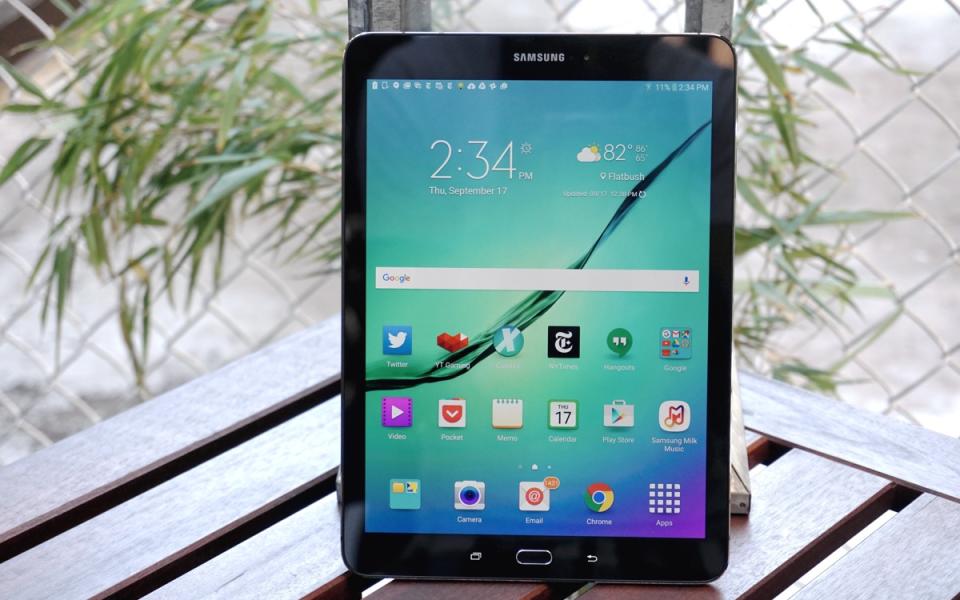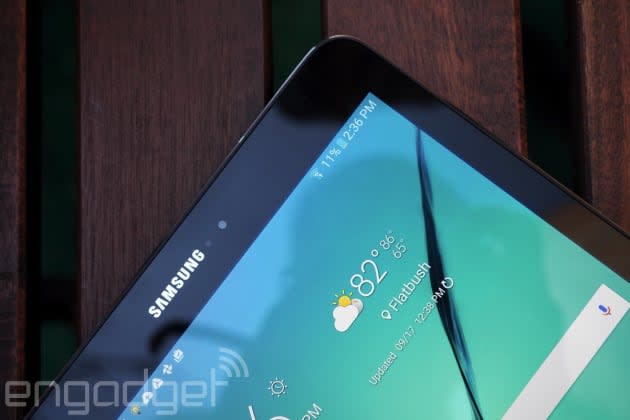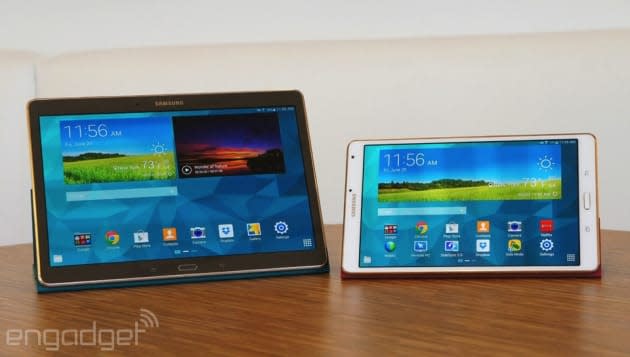Samsung Galaxy Tab S2 review: Insanely thin, but not much of an upgrade

A year ago, when Samsung debuted its original Galaxy Tab S, we noted how rare it had become to review a high-end tablet that wasn't from Apple. Well, the situation hasn't changed much today -- in fact, it's even more unusual to see a premium Android tablet. But of course, Samsung, ever tenacious and emboldened by its Android dominance, isn't one to give up without a fight. Thus, we have the Galaxy Tab S2 ($499 for the 10-inch model), which does away with last year's widescreen display in favor of a squarer 4:3 screen. Samsung also refined its tablet design even further, delivering a device that's thinner and lighter than Apple's iPad Air 2 (and that's not the only similarity). But while it's hard to mess up a good thing, Samsung somehow managed to do just that by severely hampering the Tab S2's battery life in exchange for an even thinner physique.
Hardware

Simplicity. That's really the most defining characteristic of the Galaxy Tab S2. The dimpled rear case from the last model -- which felt to me like Samsung was trying just a bit too hard to me -- is gone. Now there's a smooth, plastic cover (available in black, white and gold), which thankfully gives the tablet a bit more grip. In addition, its new squarer aspect ratio for the 9.7-inch display (there's also a $399 8-inch model) makes the Tab S2 look better proportioned. We're more used to seeing letter-sized paper, after all, instead of legal pads (which widescreen tablets always seem to resemble). The closest thing to "bling" on the Tab S2 is its chamfered metal border, which encircles the front of the device.
Frankly, it's nice to see Samsung tone things down a bit. The Galaxy Tab S2 is perhaps the most subdued device we've seen from the Korean electronics giant -- it's basically the complete opposite of the giant, mirror-backed, curve-screened Galaxy S6 Edge+. But the tablet is all the better for it. It's among the few Samsung devices that I simply like holding. That's partially due to the soft-touch material used for its back cover, but also because it's really thin and light, clocking in at 5.6 millimeters thick and 0.87 pound. It beats out the iPad Air 2 in both respects, though you'd be hard-pressed to notice a difference. Impressively, despite being so dainty, the Tab S2 feels just as sturdy as the last model, with very little flex in the case.

Those specs make it a big tablet that feels surprisingly comfortable in your hand. There's no wrist strain from holding it one-handed, or when watching longer videos. It also makes traveling with the Tab S2 a cinch. I often forgot it was in my messenger bag during my commute -- and that's really Samsung's big selling point. Sure, you can find plenty of cheap Android tablets these days, but you'll either have to deal with a smaller screen size or a bit more heft. The Galaxy Tab S2 is for people who are willing to pay a bit more for a premium experience.
Just like many of Samsung's devices this year, the Tab S2 also includes a fingerprint reader in the home button. For the most part, it serves as a simple way to unlock the tablet securely. Overall, it worked about as well as it did for me on the Galaxy S6 Edge+. It's easy to set up, and it's generally accurate when it comes to recognizing your fingerprint (just be sure to keep your paws dry and grime-free).
While the Galaxy Tab S2 feels like the product of a wiser, more experienced Samsung, it's hard not to notice how closely it resembles the iPad Air 2. Both devices now have 9.7-inch (4 x 3) screens, and both are incredibly thin and light. For a company that's been accused (and convicted) of stealing ideas from Apple, it's a shame to see it once again return to that well. Samsung reps told us that the company wanted to avoid fragmentation in the tablet market by changing up its aspect ratio, but really that just meant it wanted to be more like Apple.
Display

Praising Samsung displays just never seems to get old -- probably because it's one thing the company does very, very well. Like its predecessor, the Tab S2 has a stunning Quad HD Super AMOLED display as its centerpiece. It makes everything look great, be it movies, photos or just plain text. Since we're dealing with a squarer screen this time around, though, you can expect to see plenty of black bars around widescreen video content. That's something I've just gotten used to in my many years of media watching. And despite not being perfectly proportioned for video, I never really felt like I was missing out on anything in the Tab S2 compared to last year's model.
In fact, video once again felt like the best use for the Tab S2. Its thin-and-light stature made it ideal for lounging in bed and streaming Frasier reruns and catching up on Steven Universe. All those pixels, together with the displays' high contrast ratio, sharp colors and inky blacks makes HD video look almost 3D-like at times. It's particularly impressive with 2K video, which suits the Quad HD resolution, or downscaled 4K clips. It's hard to explain until you see it in person, but the Tab S2 is one example of why there's more to making a great display than just focusing on resolution. It even looks better than some native 4K displays I've seen.
Software

Again, no surprises here. The Tab S2 is running a TouchWiz-skinned version of Android 5.1 Lollipop. As I mentioned in my Galaxy S6 Edge+ review, Samsung has come a long way from its days of cramming Android full of tons of useless apps and half-baked features. There are still plenty of Samsung apps available, like S Translator and the chat app AllTogether, but you'll have to choose to install them from the Galaxy Apps store. That's a better option than having your phone stuffed with junky software. And the few preinstalled apps on the Tab S2 are pretty useful, especially Microsoft options like Word, OneDrive and Skype.
There's really not much to complain about with the Tab S2's software. The home and lock screens are fairly clean from the get-go, and even though Samsung's built-in web browser and email apps are kind of weak, it's easy enough to just replace those shortcuts with Chrome and Gmail (which are installed by default). At this point, I wonder why Samsung even bothers including its own apps when there are so many better alternatives out there. It's not hard to imagine a future where its partnership with Microsoft eventually leads to bundling an Android version of Edge and Outlook to replace Samsung's apps.
Among the few software changes from last year, the Tab S2 is now slightly better at multitasking. Samsung simplified the process of getting two apps to run side by side (a feature that even Apple is lifting for iOS 9). You can also share text and media between some apps, although in my testing I found that to be hit-or-miss. Developers will still need to include some special code to make their apps compatible with Samsung's multitasking features, but reps told us even they're surprised by how quickly developers are jumping aboard.
And while we weren't able to test out the Tab S2's new smart TV features, they sure sound intriguing. It can send video wirelessly to modern smart TVs, and you can also pipe in content from newer Samsung smart TVs right to the tablet. Samsung demoed both features for us briefly, but it's hard to tell if they work as advertised.
Camera
Just like last year's model (and all of Samsung's other recent tablets), the Galaxy Tab S2 packs in an 8-megapixel rear camera and a 2.1MP front-facing shooter. While it won't outclass the more powerful 16MP cameras on Samsung's recent batch of phones (which are pretty much the best smartphone cameras outside of the iPhone), the Tab S2 manages to take sharp, colorful pictures fairly quickly. It won't ever be a primary shooter, but it's ideal if you're stuck somewhere with just the tablet and no access to your phone. The Tab S2's camera isn't just for taking pictures, either -- it can shoot up to QHD video (2,560 x 1,440 resolution), although really you're better off sticking with the more widely accepted 1080p video. Again, you probably won't be using the Tab S2 much for video, but it still manages to take some decent-looking footage.
Performance

Aside from the faster Exynos 5433 octa-core processor (consisting of a quad-core 1.9GHz chip and a quad-core 1.3GHz chip), the Tab S2 keeps the same 3GB of RAM as its predecessor. It's plenty fast -- I never had any issues with slowdown while playing videos, juggling several apps or playing games -- but it didn't feel significantly faster than the last model. It also comes with 32GB of storage, which you can expand with SD cards as large as 128GB.
The big issue for Samsung is that the original Tab S was simply too good; any attempt at an upgrade would have to be wildly better to get noticed. But that's tough when we've basically reached a point of diminishing returns with mobile hardware. The chips everyone used last year for high-end devices are still "good enough" for most tasks today.
Samsung Galaxy Tab S2 | Samsung Galaxy Tab S | Galaxy Note 10.1 2014 | iPad Air 2 ** | |
|---|---|---|---|---|
Vellamo 2.0 | 4,522 | 1,672 | 2,735 | N/A |
SunSpider 1.0.2 (ms) | 1,096 | 1,109 | 1,069 | 303 |
3DMark IS Unlimited | 11,892 | 12,431 | N/A | 21,659 |
GFXBench 3.0 Manhattan Offscreen (fps) | 13 | 5.5 | N/A | 32.4/24.6 |
CF-Bench | 41,341 | 31,695 | 31,567 | N/A |
*SunSpider: Lower scores are better. **Not all of our Android benchmarks are cross-compatible with iOS. | ||||
Curiously, the Tab S2 also has a significantly smaller battery than last year's model -- the 9.7-inch version we tested packs in a 5,870mAh cell, compared to 7,900mAh on last year's device. That's a real shame, since the long battery life of the original Tab S was one of the things we liked most about it. In our test, which consists of looping an HD video at 50 percent screen brightness, the Tab S2 lasted around seven and a half hours -- a steep drop from 12.5 hours on the previous model.
Samsung's dogged pursuit at building the thinnest and lightest tablet ever was likely the big reason we lost so much battery life. And honestly, I question if it was even worth it. Last year's model was already impressively thin and light. Is it really worth losing almost half of its productive battery life just for a minor thickness and weight spec win? I can't imagine anyone would think so, unless you're a Korean electronics company that desperately wants to one-up your big-name American competitor.
The competition

Let's face it: You don't really have many high-end Android tablet options. But what's truly strange about the Tab S2 is that its greatest competitor in the Android arena is likely the original Tab S (above), which you can find used or refurbished for around $300 online (for the 10-inch model). Its screen is just as gorgeous as the Tab S2's, and the widescreen format will be better-suited to movie watching. The Tab S is also especially tempting if battery life is important to you (and why wouldn't it be?).
Amazon's refreshed Fire HD tablets are also good options at about half the price. They, too, are impressively thin, and there are plenty of more vibrant color options than the Tab S2. But while you'll get plenty of Amazon content integration in those, remember you won't get full access to the Google Play app store.
But of course, the iPad Air 2 is what you'll likely be judging the Tab S2 against when you're looking for a new tablet. And if you're eyeing the 8-inch Tab S2, the new iPad Mini 4 is worth considering as well: It offers basically the same specs as last year's iPad Air 2, except in a smaller form factor. While the Tab S2 is slightly thinner and lighter, Apple's tablets win out due to their better battery life (around 12 hours), and stronger library of tablet apps (that's one area where Android may never catch up with Apple). Honestly, if you're tempted by Apple's slates, they're likely the better choice for you. The Tab S2 is very good at being an Android tablet, but you'll need to be fully committed to Android to make it worthwhile.
Wrap-up

Leave it to Samsung to ruin one of its best products. The original Tab S had plenty going for it -- except few people bought it. That's one reason Samsung might have chosen to make its new model more iPad-like. But by focusing on the spec race with Apple, instead of what's actually best for consumers, Samsung ended up sacrificing one of its best features: long runtime. To its credit, Samsung is positioning the Tab S2 as a device that lives in your home, so it might not need a dozen hours of battery life. But really, that just feels like an excuse.


























